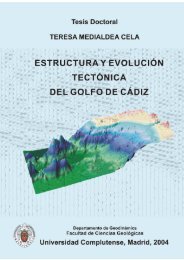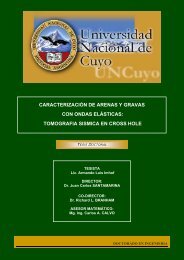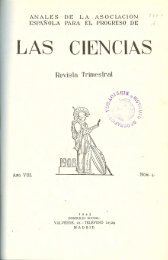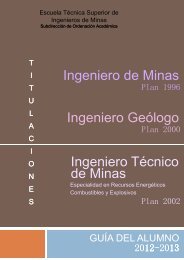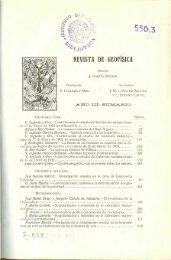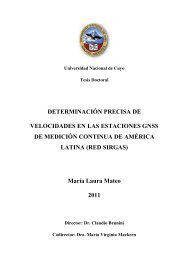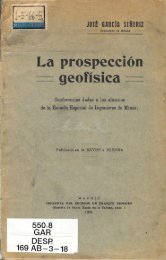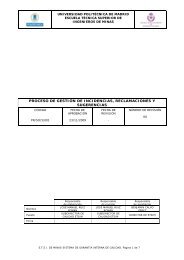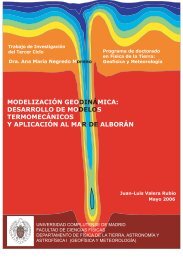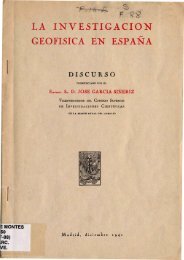estructura gravimétrica y magnética de la corteza del suroeste ...
estructura gravimétrica y magnética de la corteza del suroeste ...
estructura gravimétrica y magnética de la corteza del suroeste ...
You also want an ePaper? Increase the reach of your titles
YUMPU automatically turns print PDFs into web optimized ePapers that Google loves.
Nieves Sánchez Jiménez<br />
106<br />
H<br />
reg<br />
( f )<br />
= 1 − e<br />
A su vez, el filtro residual se expresará como:<br />
−z<br />
( f )<br />
[ 1 − H ( f ) ] H ( f )<br />
H res(<br />
f ) = reg<br />
opt<br />
Los valores x(f), y(f) y z(f) se pue<strong>de</strong>n obtener directamente <strong>de</strong>l análisis <strong>de</strong>l espectro<br />
<strong>de</strong> potencia. Una vez diseñados los filtros para <strong>la</strong>s fuentes regional y residual, si<br />
multiplicamos, en el dominio <strong>de</strong> <strong>la</strong>s frecuencias, éstos por el espectro <strong>de</strong> <strong>la</strong> señal total,<br />
obtendremos los espectros <strong>de</strong> <strong>la</strong>s fuentes regional y residual. A su vez, <strong>la</strong> transformada<br />
inversa <strong>de</strong> estos espectros nos dará <strong>la</strong> anomalía <strong>de</strong> dichas fuentes en el dominio <strong>de</strong>l espacio.<br />
Jacobson (1987) <strong>de</strong>scribe un filtro simi<strong>la</strong>r al <strong>de</strong>scrito por Wiener a partir <strong>de</strong>l trabajo<br />
<strong>de</strong> Spector y Grant (1970). A partir <strong>de</strong>l espectro <strong>de</strong> potencia para una distribución <strong>de</strong> masas<br />
en profundidad (ver apartado 6.2.2), si P(f) es el espectro <strong>de</strong>bido a dos masas m0 y m1<br />
situadas a profundida<strong>de</strong>s z0 y z1 respectivamente, y P1(f) representa el espectro <strong>de</strong>bido a <strong>la</strong><br />
masa más profunda m1, se pue<strong>de</strong> aproximar:<br />
P<br />
y, por lo tanto,<br />
P<br />
() f<br />
() f<br />
1<br />
≈<br />
4π<br />
2<br />
G<br />
2<br />
2 2 2 −4π<br />
f z1<br />
4π<br />
G ( m1<br />
e )<br />
1<br />
=<br />
2 −4<br />
π f z0<br />
2 −4<br />
π f z1<br />
2<br />
( m0<br />
e + m1<br />
e ) ⎛ m ⎞ 4π<br />
f ( z −z<br />
)<br />
P<br />
1<br />
() f<br />
≈<br />
⎛ m<br />
⎜<br />
⎝ m<br />
0<br />
1<br />
⎞<br />
⎟<br />
⎠<br />
2<br />
e<br />
P<br />
() f<br />
f 4π<br />
⎜<br />
⎝ m<br />
( 1 0 )<br />
1<br />
z z −<br />
La ecuación anterior <strong>de</strong>fine un filtro por el que hay que multiplicar al espectro <strong>de</strong><br />
potencia <strong>de</strong> una anomalía dada para obtener como resultado <strong>la</strong> parte regional, es <strong>de</strong>cir,<br />
multiplicar P(f) por <strong>la</strong> función:<br />
m<br />
⎜<br />
⎝ m<br />
e<br />
1<br />
f 4<br />
2<br />
⎛ 0 ⎞ π −<br />
1<br />
⎟<br />
⎠<br />
( 1 0 )<br />
1<br />
z z<br />
+<br />
Para obtener el efecto regional en el dominio <strong>de</strong>l espacio, aplicamos <strong>la</strong> inversa <strong>de</strong> <strong>la</strong><br />
transformada <strong>de</strong> Fourier, y finalmente <strong>la</strong> anomalía residual se obtiene por diferencia entre el<br />
efecto total y el regional.<br />
+<br />
0<br />
1<br />
⎟<br />
⎠<br />
e<br />
1<br />
0<br />
+ 1



